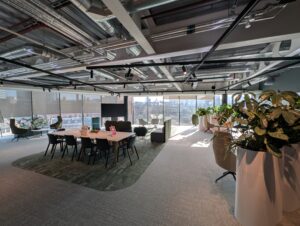Several local authorities have included major tree planting initiatives as part of their climate declarations – but can we plant our way to carbon neutrality by 2030?
1st Vice President of the Directors of Environment, Economy, Planning & Transport (ADEPT) and Chair of the Local Adaptation Advisory Panel (LAAP) Nigel Riglar, discusses more.
Can we plant our way out of the climate emergency? Unfortunately, the answer is not straightforward.
If you look out of your window you can probably see a patch of grass.
That patch of grass or pitch is already sequestering – locking up – carbon. Most of the carbon associated with your patch of grass is in the soil. If you ploughed it up or developed it, you’d release some of that carbon into the atmosphere.
Equally, you could lock up more carbon by changing how you manage your patch of grass, or growing more plants on it such as hedges or trees. But it is crucial to remember your main carbon asset is already sat underground – investing in better land management and more vegetation is as much about protecting that, as it is about sequestering more. The grass, shrubs or trees above ground are the icing on the cake.
For example, you could plant your patch of grass with trees. For the first 10-20 years the trees aren’t adding much over and above the grass, as the saplings are growing and putting on wood slowly. In fact, it’s probably 20-30 years before you start to get significant new carbon locked up. You might get net gain quicker if you mixed in native grassland, wetland and / or saltmarsh restoration. It would certainly be better for biodiversity net gain.
Back to the question – can we plant our way to achieving net zero carbon by 2030? Simply the answer is no, there isn’t time. Whilst we welcome the recent budget announcement that will see the UK plant a ‘forest larger than Birmingham’, we also know that it will many years to make a difference to our carbon emissions.
On any timescale, the net gains that changing land use can offer look small against the scale of our total emissions. Indeed, thinking how little ‘headroom’ we’d gain by planting lots of trees puts the staggering scale of emissions – from energy use, transport and so on – into perspective.
The only way to really achieve the 2030 climate emergency target is to very rapidly decarbonise transport, business and the domestic sector. Indeed, there’s an argument that land use change shouldn’t count towards net zero at all.
Does that mean planting trees and improving land management should be a lower priority? Far from it. Even though those non-CO2 emissions aren’t reported locally, they still exist, and still need addressing if we want to tackle the climate emergency. As some of them come from agriculture, it shifts the focus from simply trying to max out on sequestration by creating woodlands, to supporting a broader transition in land use. That transition should support a range of strategies that combine sequestration with ways of reducing emissions while keeping land productive, and help wildlife recover.
It also matters for the long term. The bigger wins from land use will build after 2030, to the 2050s and beyond. On that timescale they start to make a substantial contribution, and also help us adapt to temperature increases locked in by historic emissions.
We are in no doubt that investing at scale in green infrastructure is the right thing to do. The aim must be to ‘turn the curve’ and make sure that there is no more net loss of green infrastructure.
Local authorities are legacy investors in their areas and spending on green infrastructure is a classic long-term investment. It has value for carbon offsetting, biodiversity net gain and agricultural production, as well as providing flood prevention, urban cooling, public health and wider recreational and amenity services. Local authorities can own land, can buy land and work in partnership with local land-owners to change land usage.
Having an outrageous ambition for our green infrastructure is not something we can shy away from. An increasingly urbanised world, even if decarbonised, will still require the eco-system services it provides. The deal between urban and rural needs to be recast and only local authorities are truly in a position to coordinate this effort at the local level.
More information about ADEPT can be found on its website: www.adeptnet.org.uk
















